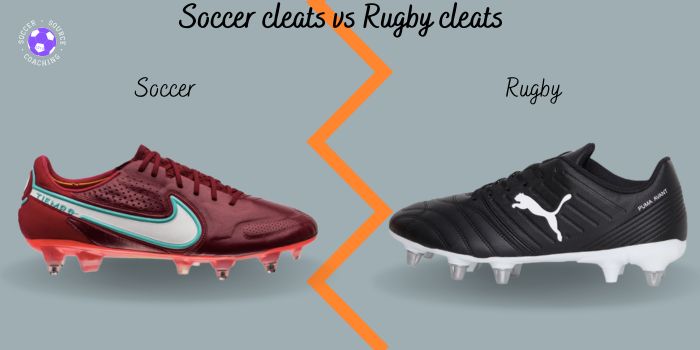Rugby is becoming an increasingly popular sport in not just America but also in the Rest of the World, whether it be rugby 7’s or a full 15v15 match. Rugby is played on very similar surfaces to soccer and has similar movements that involve quick changes of direction, so does this mean that soccer cleats can be worn for rugby, and vice versa? This soccer cleats vs rugby cleats guide will detail the differences, go over frequently asked questions about the topic, and the best soccer cleats for rugby.
Soccer Cleats vs Rugby Cleats | Quickly summarized
Soccer and rugby are 2 different sports that require different demands from athletes.
So although the cleats may look similar there are subtle differences that are specialized for their sport.
Soccer cleats will have 10 to 16 shorter studs, to help aid in quick movement on grass and turf, as where rugby will have a minimum of 8 longer studs that provide more grip and stability.
The construction of the rugby cleat is designed to provide the athlete as much comfort and protection as possible during physical contact, which means on average it is heavier than soccer cleats.
The cleats in rugby will also differ depending on which position the athlete plays.
If an athlete plays as a Back the cleat will tend to be lighter and have a more bladed shape to help make sharp changes of direction.
This position is more suitable for an athlete to wear soccer cleats in rugby.
On the other hand Forwards in rugby will wear a mid to high-cut cleat, that offers great ankle support and stability while digging into the surface during scrums, rucks, and lineouts.
This position would be less suitable for an athlete to wear soccer cleats during rugby.
When it comes to playing soccer, rugby cleats can be worn but it is advisable not to wear them.
If you need to wear rugby cleats to play soccer as a last resort, check with the league but remember the referee will have the final say as to whether they can be worn or not.
It is recommended that where possible you where the correct cleats for the corresponding sport to decrease the risk of injury to yourself or other athletes.
The differences between soccer boots and rugby boots

Soccer and rugby cleats/boots do share some similarities, however, each cleat/boot is designed specifically for their respective sport.
Below is a table highlighting the key differences between soccer and rugby cleats:
| Feature | Function in Soccer Cleats | Function in Rugby Cleats |
|---|---|---|
| Studs | 10-16 shorter studs, evenly distributed for traction and quick movement on grass or turf | Minimum of 8, longer studs, to provide grip and stability on grass |
| Stud Length | Shorter, typically 1.27 – 1.905 cm (1/2 inch – 3/4 inch) for low profile and quick movements | Typically 1.905 – 2.1 cm (0.75 inches – 0.86 inches) for added stability on grass |
| Weight | Lighter, typically 170-297 grams / 6-10 ounces for agility and speed | Varies depending on position and player preference, but typically 170-510 grams or 6-18 ounces. |
| Cleat shape | Round or bladed for multidirectional movements and quick turns | Bladed for traction and stability when pushing off or making cuts |
| Materials | Lighter materials like synthetic leather or mesh for breathability and flexibility | Heavier materials like leather or synthetic leather for durability and protection |
| Construction | Low-cut or mid-cut for mobility and range of motion | Varies depending on position and player preference, but typically mid-cut for ankle support and stability |
| Toe box | Rounded for control and precision when kicking | Squared or tapered for a larger surface area when pushing |
Please beware that some soccer and rugby cleats may not fit into the categories provided.
This is because there is a wide range of brands, models, and positions that will affect the weight and design.
As sports companies are also looking to improve on previous models, the technologies used may alter the design and weight of the cleats as well.
The difference between rugby cleats depending on the position
| Feature | Rugby Backs | Rugby Forwards |
|---|---|---|
| Studs | Minimum of 8 studs, to provide grip and stability on grass | Minimum of 8, longer studs, to provide grip and stability on grass |
| Stud Length | 1.905-2.1 cm (0.75 inches to 0.86) typically tend to be shorter. | 1.905-2.1 cm (0.75 inches to 0.86) typically tend to be long |
| Weight | Lighter, typically 170-297 grams / 6-10 ounces for agility and speed | Heavier, typically 340-510 grams / 12-18 ounces for added durability and protection in contact situations |
| Cleat shape | Bladed for traction and stability when pushing off or making cuts | More circular or square for stability and power in scrums |
| Materials | Lighter materials like synthetic leather or mesh for breathability and flexibility | Heavier materials like leather or synthetic leather for durability and protection in contact situations |
| Construction | Mid-cut for ankle support and stability | High-cut for ankle support and stability in scrums |
| Toe box | More rounded for control and precision when kicking | Squared or tapered for a larger surface area when pushing off |
In rugby, there are a total of 15 players on the pitch for a team with the positions falling into either the ‘Forwards’ or ‘Backs’.
The ‘Forwards’ role in rugby is to win and retain possession of the ball and requires a lot of static and explosive strength.
These are the players who are involved in the scrums, line-outs, and rucks.
While the ‘Backs’ role in rugby is to create and score tries.
They are usually quicker and more agile than the Forwards.
To meet the demands of their position, the forwards and backs will have different rugby cleats.
FAQ about wearing soccer or rugby cleats
These are some of the most frequent questions asked about soccer cleats vs rugby cleats.
Can you use soccer cleats for rugby?
While you are able to wear soccer cleats for rugby it is recommended that you wear rugby-specific cleats.
The main reason for this is that soccer cleats may not provide the same traction, support, and stability while playing on rugby surfaces.
Rugbly also involves a lot of physical contact with opposition players, such as tackling, scrummaging, and rucking.
This can place added stress on the feet and ankles which soccer cleats are not manufactured for.
Although not a perfect choice, If you play as a Back in rugby then soccer cleats would be an ok choice to wear.
If you are an athlete who takes soccer and rugby seriously then getting a pair of rugby cleats would be the best option.
However, if you play rugby recreationally as a back then soccer cleats will be ok too.
If you play rugby recreationally as a forward, you would be better off wearing rugby cleats.
Soccer cleats are allowed in rugby providing they meet the following requirements:
- Have a minimum of 8 plastic or metal studs
- A stud length that is not greater than 2.1cm (0.83 inches)
- Metal studs cannot be worn on artificial surfaces
- The studs must not have any sharp edges or burrs (rough edges)
- The cleat is not modified in a way that could increase the chance of injury occurring to other players, such as adding extra studs or altering the shape and size of existing studs
It is important to remember that the referee will have the final say as to what cleats are acceptable and not acceptable to play in for rugby.
Can you use soccer boots for touch rugby?
Yes, soccer cleats are great to use for touch rugby!
Touch rugby is a non-contact sport, so athletes do not need the extra support and protection that rugby cleats offer during physical contact.
Soccer cleats will allow athletes to make quick, agile movements while playing touch rugby.
However, it is important for athletes to take into consideration the playing surface.
For playing surfaces that are muddier, wetter, or has longer grass athletes may want to consider cleats with longer studs that allow for better traction.
If the playing surface is on an artificial pitch, athletes would have to avoid wearing cleats that have metal studs.
Similar to rugby, the referee in touch rugby will have the final say on what cleats are deemed safe or unsafe to use.
Can you use rugby boots for soccer?
Although not prohibited, rugby cleats can be used for soccer but it is strongly not recommended.
The stud length and support the rugby cleat provide to the athlete’s foot will hinder their ability to play soccer.
On top of negatively impacting performance, the athlete will increase their risk of injuring themselves or other players on the pitch.
These are the specifications cleats must meet to be worn in soccer:
- The studs on the outsole of the shoe must be conical or blade-shaped.
- Studs can be no longer than 2.1cm (0.83 inches)
- There must be no sharp edges or protrusions present on the studs
- Metal studs are usually not allowed (check with the organization or league)
- Cleats cannot be altered which could increase the risk of injury, such as adding extra studs, lengthening the studs, or changing the shape of the studs.
As always the official running the game will have the last say as to whether or not the footwear is appropriate for soccer.
Best soccer cleats for playing rugby
If you play soccer and rugby and want to wear soccer cleats, the best soccer cleats for playing rugby would be the Puma Future Z.
If you are looking at buying soccer cleats and don’t know where to start this is a comprehensive soccer cleats buying guide to make the process simpler.
This is a good guide to buying rugby cleats.

These are my reasons why:
- Lightweight and Comfortable
The Puma Future Z is designed with lightweight and breathable materials that provide a comfortable fit for the wearer.
This can be especially important for backs in rugby who need to be quick on their feet and make sudden movements.
- Good Traction
The soleplate of the Puma Future Z is designed with a unique stud pattern that offers excellent traction on grass or turf and offers a mix of conical and bladed studs.
This can help players maintain their footing and make quick cuts on the field.
- Durable and Protective
The Puma Future Z features a durable outer shell that helps protect the foot from impacts and collisions with other players.
This can be especially important for rugby where physical contact occurs frequently.
>> Check Prices <<
Final thoughts | Key takeaways
When deciding whether or not you should wear soccer or rugby cleats these are the factors you need to take into consideration:
The level of soccer and rugby the athlete plays
It is important to take into consideration the level you are playing soccer and rugby.
If you are playing soccer and have a low level of rugby, then soccer cleats are an ok option to wear for rugby in a ‘Back’ position.
If you are playing a low level of rugby in a ‘Foward’ position then I would avoid wearing soccer cleats and wear rugby cleats instead,
This will provide your feet with adequate support and stability when making physical contact with opposition players.
If you are a competitive rugby and soccer player then I would recommend getting soccer and rugby cleats.
It is important to note that rugby cleats shouldn’t be worn for soccer and even if you do try to wear them the referee could prevent you from playing because they deem the footwear unsafe.
The surface of the playing field
Another factor to take into consideration is the playing surface.
On a firmer surface, soccer cleats could improve traction while playing rugby, however, you will miss out on the benefits of the stability and support the rugby cleats offer when making contact.
In harsher pitch and weather conditions rugby cleats will always be superior to soccer cleats for playing rugby
Ankle support
If you are an athlete that requires a cleat with more stability and enjoys playing rugby and soccer then getting separate cleats for both sports would be recommended.
Especially for rugby where there is more physical contact that can put more stress and pressure on the feet and ankles.
Wearing the appropriate footwear for each sport can significantly decrease the chance of injury.
Check with the sports organizers
If you are unsure about wearing soccer cleats for rugby or rugby cleats for soccer you check with the sports league/organization beforehand.
This is because if you turn up with cleats that are ineligible, you will not be allowed to participate.
Hopefully, this soccer cleats vs rugby cleats guide has given you a better understanding of the differences, benefits, and questions around the topic.
Thank you for reading and please share this guide with any athletes or parents who are in this dilemma.
Toby
Wearing soccer cleats and shoes for other sports
If you found this soccer cleats vs rugby cleats guide helpful you would also gain knowledge from similar posts:
- Soccer Cleats Vs Lacrosse Cleats
- Soccer Cleats Vs Baseball Cleats
- Soccer Cleats Vs Football Cleats
- Indoor Soccer Shoes Vs Basketball Shoes
- Indoor Soccer Shoes Vs Running Shoes
- Indoor Soccer Shoes Vs Volleyball Shoes
- Indoor Soccer Shoes Vs Tennis Shoes
- Indoor Soccer Shoes Vs Turf Shoes
Best Soccer Cleats By Position
If you play a certain position in soccer some cleats are more beneficial than others.
These are the best cleats for each position:

